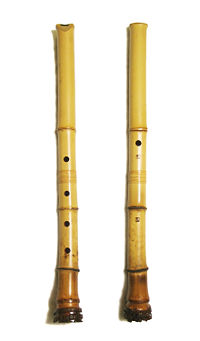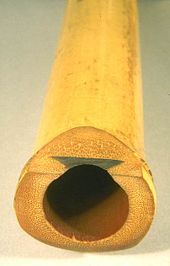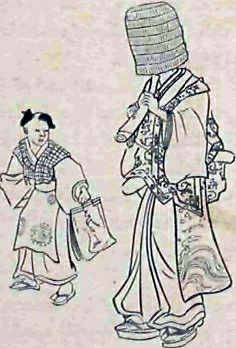Shakuhachi
The shakuhachi (尺八 IPA: [ˈʃakʊˌhatʃi]) is a Japanese end-blown flute which is held vertically like a recorder, instead of transversely like the Western transverse flute. Its name means "1.8 foot", its size. It is traditionally made of bamboo, but versions now exists in wood and plastic. It was used by the monks of the Fuke sect of Zen Buddhism in the practice of suizen (blowing meditation). Its soulful sound made it popular in Western 1980s pop music.
Overview
The name shakuhachi means "1.8 foot", from its size. It is a compound of two words:
- shaku (尺) means "foot" (an archaic measure of length), equal to 30.3 centimeters (0.994 of the English foot) and subdivided in ten (not twelve).
- hachi (八) means "eight", here eight sun or tenths of a shaku.
Thus, "shaku-hachi" means "one foot eight" (almost 55 centimeters), the standard length of a shakuhachi. Other shakuhachi vary in length from about 1.3 shaku up to 3.3 shaku. (The longer the shakuhachi, the lower its tuning.) Although the sizes differ, they are all still referred to generically as "shakuhachi".
A recorder player blows into a duct, also called "fipple", and thus has limited pitch control. The shakuhachi player blows as one would blow across the top of an empty bottle, but the opposite edge of the shakuhachi has a sharp edge, allowing the player substantial pitch control. The five finger holes are tuned to a pentatonic scale with no half-tones, but the player can bend each pitch as much as a whole tone or more, using techniques called meri and kari, in which the blowing angle is adjusted to bend the pitch downward and upward, respectively. Pitches may also be lowered by shading or partially covering finger holes. Since most pitches can be achieved via several different fingering or blowing techniques on the shakuhachi, the timbre of each possibility is taken into account when composing or playing. The shakuhachi has a range of two full octaves (the lower is called otsu, the upper, kan) and a partial third octave (tai-kan). The different octaves are produced using subtle variations of breath and embouchure.
A 1.8 shakuhachi produces D4 (D above Middle C, 293.66Hz) as its 'base' note - the note it produces with all five finger holes covered, and a normal blowing angle. In contrast, a 2.4 shakuhachi has a base note of A3 (A below Middle C, 220Hz). As the length increases, the spacing of the finger holes also increases, stretching both fingers and technique. Longer flutes often have offset finger holes, and very long flutes are almost always custom made to suit individual players. Many of the honkyoku in particular are intended to be played on these longer flutes to achieve the appropriate feeling.
Much of the shakuhachi's subtlety (and player's skill) lies in its rich tone colouring, and the ability for its variation. Different fingerings, embouchures and amounts of meri can produce notes of the same pitch, but with subtle or dramatic differences in the tone colouring. The honkyoku pieces rely heavily on this aspect of the instrument to enhance their subtlety and depth.
Shakuhachi are usually made from the root end of a bamboo culm and are extremely versatile instruments. Holes can be covered partially (1/3 covered, 1/2, 2/3, etc.) and pitch varied subtly or substantially by changing the blowing angle. Professional players can produce virtually any pitch they wish from the instrument, and play a wide repertoire of original Zen music, ensemble music with koto, biwa and shamisen, folk music, jazz, and other modern pieces.
Due to the skill required, the time involved, and the range of quality in materials to craft bamboo shakuhachi, one can expect to pay from USD 500 to USD 5,000 for a new or used flute. Because each piece of bamboo is unique, shakuhachi cannot be mass-produced, and craftsmen must spend much time finding the correct bore shape for each individual flute to result in correct pitch over all notes. Specimens of extremely high quality, with valuable inlays, or of historical significance can fetch USD 10,000 or more. Plastic or PVC shakuhachi have some advantages over their traditional bamboo counterparts: they are extremely durable, nearly impervious to heat and cold, and typically cost less than USD 100. Shakuhachi made of wood are also available, typically costing less than bamboo but more than synthetic materials. Nearly all players, however, prefer bamboo, citing tonal qualities, aesthetics, and tradition.
History
The bamboo flute first came to Japan from China via Korea. The shakuhachi proper, however, is quite distinct from its continental ancestors, the result of centuries of isolated evolution in Japan.
During the medieval period, shakuhachi were most notable for their role in the Fuke sect of Zen Buddhist monks, known as komusō ("priests of nothingness"), who used the shakuhachi as a spiritual tool. Their songs (called "koten honkyoku") were paced according to the players' breathing and were considered meditation (suizen) as much as music.
Travel around Japan was restricted by the shogunate at this time, but the Fuke sect managed to wrangle an exemption from the Shogun, since their spiritual practice required them to move from place to place playing the shakuhachi and begging for alms (one famous song reflects this mendicant tradition, "hi fu mi hachi gaeshi", "one two three pass the alms bowl"). They persuaded the Shogun to give them "exclusive rights" to play the instrument. In return, some were required to spy for the shogunate, and the Shogun sent several of his own spies out in the guise of Fuke monks as well. (This was made easier by the wicker baskets that the Fuke wore over their heads, a symbol of their detachment from the world.)
In response to these developments, several particularly difficult honkyoku pieces became well-known as "tests": if you could play them, you were a real Fuke (e.g. shika no tone). If you couldn't, you were probably a spy and might very well be killed if you were in unfriendly territory.
When the Meiji Restoration occurred in 1868, the shogunate was abolished and so was the Fuke sect, in order to help identify and eliminate the shogun's holdouts. The very playing of the shakuhachi was officially forbidden for a few years. Non-Fuke folk traditions did not suffer greatly from this, since the tunes could be played just as easily on another pentatonic instrument. However, the honkyoku repertoire was known exclusively to the Fuke sect and transmitted by repetition and practice, and much of it was lost, along with many important documents.
When the Meiji government did permit the playing of shakuhachi again, it was only as an accompanying instrument to the koto, shamisen, etc. It was not until later that honkyoku were allowed to be played publicly again as solo pieces.
Recordings
New recordings of shakuhachi music are relatively plentiful, especially on Japanese labels and increasingly so in North America, Europe, and Australia. Although the instrument is sometimes considered quaint and outdated in Japan, it is experiencing growth overseas. The primary genres of shakuhachi music are:
- honkyoku (traditional, solo)
- sankyoku (ensemble, with koto and shamisen)
- shinkyoku (new music composed for shakuhachi and koto, commonly post-Meiji era compositions influenced by western music)
Synthesized shakuhachi
The sound of the shakuhachi is also featured in western genres of music, from electronica to pop-rock to jazz music, especially after being commonly shipped as a "preset" instrument on various synthesizers and keyboards beginning in the 1980s[1]. Here is a short list of well-known tracks from various musical genres where you can hear the sound of an electronic or emulated shakuhachi:
| Year | Artist or band | Album | Song, range, notes |
|---|---|---|---|
| 1974 | Tangerine Dream | Phaedra | "Sequent C' " [full 2:18 track] |
| 1985 | Tangerine Dream | Le Parc | "Yellowstone Park" [0:00-0:05, 2:23-2:50] |
| 1985 | Tangerine Dream | Legend OST | "Opening" [0:00-0:30] |
| 1985 | Tangerine Dream | Legend OST | "Unicorn Theme" [0:00-0:10] |
| 1985 | Wang Chung | To Live and Die in L.A. (OST) | "Wake Up, Stop Dreaming" [???-???] |
| 1986 | Coil | Horse Rotorvator | "The First Five Minutes After Death" [1:15-1:45, 2:38-3:38, 4:30-end] - morbid shakuhachi. |
| 1986 | Peter Gabriel | So | "Sledgehammer" [0:00-0:16, 3:16-3:34] |
| 1987 | Coil | Gold Is the Metal | "The First Five Minutes After Violent Death" [0:30-1:30, 2:45-3:45, etc.] - morbid shakuhachi. |
| 1987 | Coil | Unnatural History III | "Music for Commercials": Liqueur [0:41-1:26] Natural Gas [03:15-04:00] |
| 1987 | Roger Waters | Radio K.A.O.S. | "Me or Him" [0:09-0:22, 1:27-1:35, 2:06-2:20, etc.] |
| 1988 | And also the trees | The Millpond Years | "The Sandstone Man" [0:33-0:39, 3:25-4:36] |
| 1988 | Sade | Stronger Than Pride | "Love Is Stronger Than Pride" [0:28-0:33, 2:08-2:14, 2:28-2:33, 3:08-3:30, etc.] |
| 1989 | The Sugarcubes (Björk's ex-band) |
Here Today, Tomorrow, Next Week! | "Pump" [2:06-2:22] |
| 1990 | Enigma | MCMXC a.D. | "Sadeness (Principles of Lust, Part 1)" [1:14-1:54, 2:56-3:16] |
| 1993 | Dave Brubeck | Late Night Brubeck | "Koto Song" [4:30-9:50] - Bobby Militello's flute emulation |
| 1994 | Klaus Schulze as Richard Wahnfried |
Trancelation | "The End - Someday" [2:17-2:36] |
| 1995 | Michael Bolton | Greatest Hits (1985-1995) | "Can I Touch You... There?" [0:00-0:04, 3:26-3:50, 4:24-5:07] |
| 1998 | Symphony X | Twilight in Olympus | "Lady of the Snow" [0:00-0:26] |
| 2003 | Linkin Park | Meteora | "Nobody's Listening" [0:00-2:57] |
Miscellanea
- It is said [citation needed] that in the medieval era there was also a martial art based around using a shakuhachi to defeat a swordsman. This is not entirely implausible, as the root end of a piece of bamboo (especially one with some root remnants intact) is extremely tough and heavy, making it effective as a blunt weapon. Further, many komusō were actually ronin, who would have been willing and able to learn a new martial art for protection if nothing else.
- Shakuhachi has traditionally been played almost exclusively by men in Japan, although this situation is rapidly changing. Many teachers of traditional shakuhachi music indicate that a majority of their students are women. The 2004 Big Apple Shakuhachi Festival in New York City hosted the first-ever concert of international women shakuhachi masters.
See also
- hocchiku (a similar, less refined, end-blown bamboo flute)
- embouchure
- Category:Shakuhachi players
Sources
ReferencesISBN links support NWE through referral fees
- ↑ The "E-mu Emulator II shakuhachi" is #9 in "20 Sounds That Must Die" by David Battino, Keyboard Magazine, October 1995
- ↑ Slang "shaku" in Glossary of Japanese Fuzoku Service
- ↑ Slang "shakuhachi" in Japanese Language Swearing
External links
Template:Cleanup-spam
- Shakuhachi info links
- Blog of Perry Yung, shakuhachi craftsman
- Archive of articles about the shakuhachi
- Shakuhachi Playing Tips
- An online calculator for the positioning of the holes while constructing a Shakuhachi - German
- Shakuhachi in Federal Prison
- Open Directory Project - Shakuhachi
- The Shakuhachi Blog - News & Information (updated regularly)
- Shakuhachi groups links
- Listing of Shakuhachi Schools and Organizations
- International Shakuhachi Society
- Shakuhachi Society of British Columbia
- Seattle Shakuhachi Society
- Australian Shakuhachi Society
- Shakuhachi Mailing List web archive
- ShakuhachiForum.com — world shakuhachi discussion
ca:Shakuhachi de:Shakuhachi es:Shakuhachi fr:Shakuhachi he:שאקוהאצ'י ja:尺八 pl:Shakuhachi pt:Shakuhachi fi:Shakuhachi sv:Shakuhachi zh:尺八
Credits
New World Encyclopedia writers and editors rewrote and completed the Wikipedia article in accordance with New World Encyclopedia standards. This article abides by terms of the Creative Commons CC-by-sa 3.0 License (CC-by-sa), which may be used and disseminated with proper attribution. Credit is due under the terms of this license that can reference both the New World Encyclopedia contributors and the selfless volunteer contributors of the Wikimedia Foundation. To cite this article click here for a list of acceptable citing formats.The history of earlier contributions by wikipedians is accessible to researchers here:
The history of this article since it was imported to New World Encyclopedia:
Note: Some restrictions may apply to use of individual images which are separately licensed.


